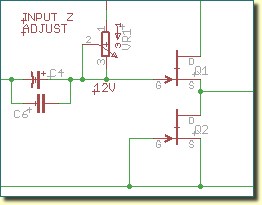| ||
FOLLOWERS
We took our inspiration from Nelson Pass and his B1 buffer, to approach to the issue of ‘impedance matching' an electric guitar to a Neve or (insert your favorite here) input... We use a single, ultra low noise JFET configured as a unity follower with a current source made from another JFET...
The output level is unity and since the output level of electric guitars is lower than the standard +4dB reference level, 12 to 15dBof additional gain will be required to bring the guitar level up to +4dB. However, this is considerably less than the 30-40db of gain required by typical direct inject boxes (DI’s). That’s less noise and less distortion and mo' guitar.
The Buffer is activated when an instrument is plugged into the front panel jack. The buffer output is relay switched to the line (or mic) input of the associated module..
To our knowledge, The Pro-Rack is the only vintage module mounting system featuring a REAL Hi-Z instrument input to the racked modules.
BUFFER INFO
The JFET buffer runs off the +24V supply and with a 1V sinewave at it's input, distortion is 0.0007%. At 2V, thd rises to a whopping 0.003%. Clipping occurs somewhere around 8V.
Considering transitent peaks from a guitar pickup (read: power chords) are below 2V , the jfet buffer never breaks a ...
The input impedence is determined by R4 and VR1. It is typically set at 1MΩ in the shop, however, it is adjustable from 500kΩ to 2.5MΩ. This adjsutement allows a subtle tailoring of the extreme high frequency response. Sometimes this is usefull with certain single coil guitars .


discrete class-a jfet buffer
jfet buffer